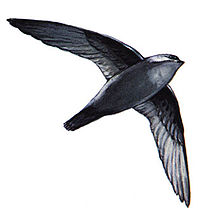Chimney Swift
| Chimney Swift | |
|---|---|
 | |
| Conservation status | |
 Near Threatened (IUCN 3.1) | |
| Scientific classification | |
| Kingdom: | Animalia |
| Phylum: | Chordata |
| Class: | Aves |
| Order: | Apodiformes |
| Family: | Apodidae |
| Genus: | Chaetura |
| Species: | C. pelagica |
| Binomial name | |
| Chaetura pelagica (Linnaeus, 1758) | |
The Chimney Swift (Chaetura pelagica) is a small bird (a type of swift).
Physical description
In flight, this bird looks like a flying cigar with long slender curved wings. The plumage is a sooty grey-brown; the throat, breast, underwings and rump are paler. They have short tails. Chimney swifts also have the shortest legs of any bird native to Ontario.
Reproduction
The breeding season of Chimney Swifts is from May through July. Their breeding habitat is near towns and cities across eastern North America. Originally, these birds nested in large hollow trees, but now they mainly nest in man-made structures such as large open chimneys. The nest is made of twigs glued together with saliva and placed in a shaded location. They will lay three to seven white eggs, which the female will cover at night. The incubation period is 19-20 days, and the fledglings leave the nest after a month. Chimney swifts can nest more than once in a season. While Chimney swifts will roost together in large numbers, it is rare to find more than one nest per chimney. Nesting sites are normally small chimneys but nests are also built in large communal roosts. It is suspected that fledged young are often fed by their parents while the young roost together in large communal roosts.
Behavior
They are long distance migrants and winter in eastern Peru; other nesting locations in South America may exist. They migrate in flocks. This species has occurred as a very rare vagrant to western Europe. The gregarious nature of this species is reflected in that two individuals of this species turned up together on the Isles of Scilly.
Feeding habits
These birds live on the wing, foraging in flight. They eat flying insects. They usually feed in groups, flying closely together and making a high-pitched chipping noise. A vigilant observer can see them entering and exiting chimneys at a high speed, almost as if they were being shot out. Their flight is distinctive: they make rapid angular turns unlike most other birds.
Their population may have increased historically with the introduction of large chimneys as nesting locations. With suitable man-made habitat becoming less common, their numbers are declining in some areas. They were listed as Threatened by COSEWIC for several years with a likely listing of the species on Schedule 1 of the Species at Risk Act.

No comments:
Post a Comment